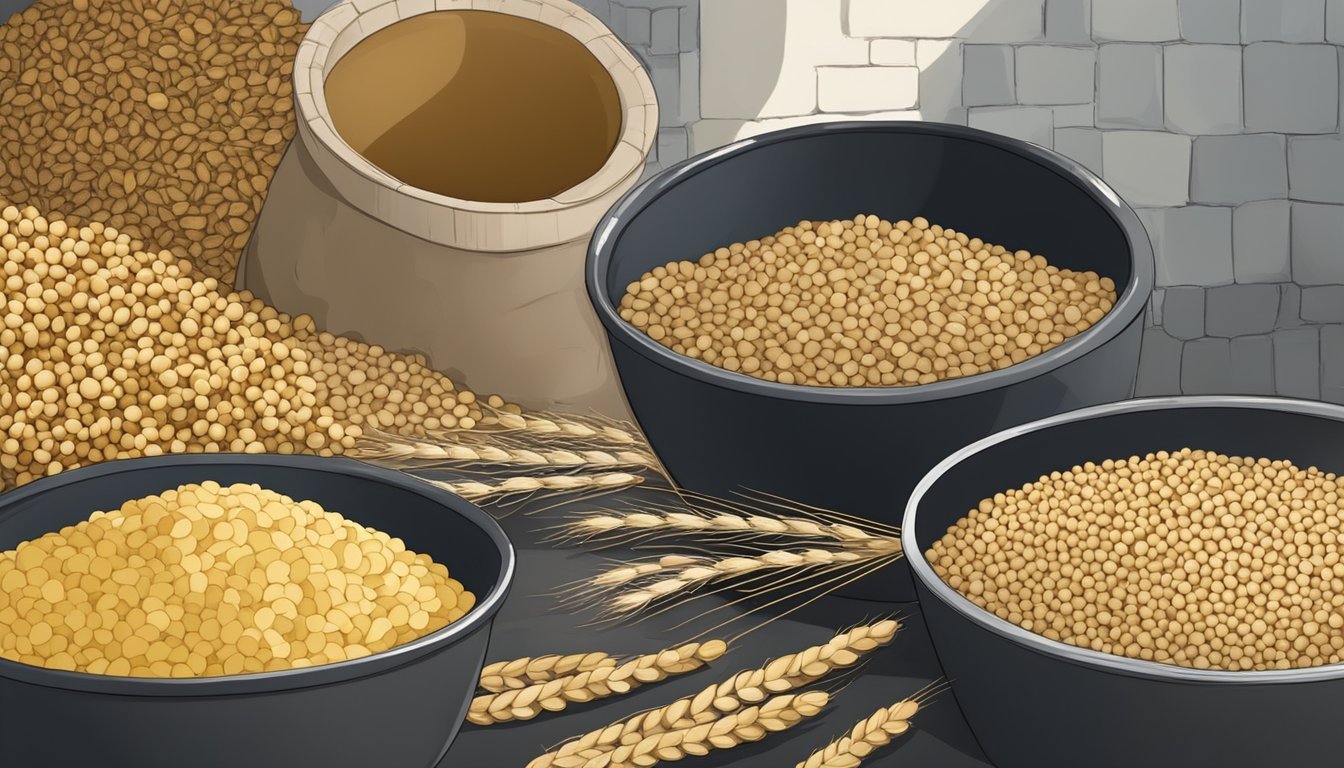How to Ferment Dajiang
Mastering Traditional Chinese Soybean Paste at Home
Dajiang is a traditional Chinese fermented soybean paste with a rich history that dates back to ancient times. As a staple in Chinese cuisine, it is revered for its savory, umami flavor that enhances a variety of dishes. It's made from a simple base of fermented soybeans, which are transformed through a natural aging process into a flavorful condiment. The making of Dajiang is a practice passed down through generations, reflecting the cultural significance and culinary expertise inherent in traditional Chinese fermented foods. (What wine goes well with fermented foods?)
The fermentation process of Dajiang encompasses a series of steps that require precision and patience. Soybeans, the primary ingredient, are carefully selected and prepared, setting the foundation for fermentation. They are then mixed with flour and other grains, which help to cultivate the natural microbes essential for fermentation. Over time, the mixture is transformed under specific conditions of temperature and humidity, a transformative period during which the distinctively deep flavors and rich aroma of Dajiang develop.
With a burgeoning interest in fermented foods worldwide for their potential health benefits and distinctive tastes, Dajiang has captured the attention of food enthusiasts and chefs alike. It plays a crucial role in Chinese gastronomy, often used to add depth to stews, marinades, and sauces. The art of making Dajiang at home can be a rewarding experience, offering a taste of China's vast culinary heritage and an opportunity to engage with the age-old traditions of fermentation.
History and Cultural Significance
Dajiang is a condiment deeply rooted in the culinary traditions of China, particularly in Northeast China. As a traditional fermented food, its origins trace back centuries, serving as a testament to the rich gastronomic heritage of the region. The fermentation process of dajiang involves natural microbes that enhance both the flavor and nutritional value of soybeans, which are its primary ingredient.
Traditional Role:
Core ingredient in daily cooking
Used for flavoring various dishes
Integral to specific regional recipes
History:
Originated in ancient times
Developed over dynastic periods
Perfected by generations of artisans
The preparation of dajiang has been honed over generations, becoming an indispensable part of Chinese gastronomy. It exemplifies the use of fermentation techniques that are common in East Asian cuisines and highlights the ingenuity of traditional methods of food preservation.
Cultural Integration:
Emblem of regional identity
Celebrated during festivals and family gatherings
Passed down through family and community traditions
Dajiang's presence on the Chinese dining table goes beyond taste; it is a culinary expression that evokes a sense of belonging and cultural identity. The practice of making dajiang has been passed down and preserved within communities, reflecting a shared history that is both personal and communal. As such, Dajiang is not merely a food product but also a cultural artefact, symbolizing the enduring legacy of traditional fermented foods in China.
Understanding Dajiang
Dajiang is a traditional fermented soybean paste boasting a rich history, particularly in Northeast China. This staple condiment is a result of a complex fermentation process involving diverse microflora that crucially dictate the final product's flavor and quality.
One of the key microbial groups in Dajiang fermentation includes Bacillus species. These spore-forming bacteria play an essential role in breaking down proteins and fats, contributing to the soybean paste's characteristic taste and texture.
Another significant group is lactic acid bacteria (LAB), which commonly encompasses Lactic Acid Bacteria, Enterococcus spp., and Leuconostoc spp. These organisms are pivotal in producing lactic acid, enhancing the paste's safety, palatability, and shelf-life. LAB's metabolic activities are largely responsible for the sour taste and preserved state of Dajiang.
Alphaproteobacteria also constitute part of the microorganisms present in Dajiang. Although in smaller numbers compared to Bacillus and LAB, these bacteria participate in the fermentation process, contributing to the complexity of the flavor profile.
Microorganism Group: Bacillus spp.
Influence on Dajiang: Texture and flavor
Microorganism Group: Lactic Acid Bacteria
Influence on Dajiang: Acidity and preservation
Microorganism Group: Enterococcus spp.
Influence on Dajiang: Flavor development
Microorganism Group: Leuconostoc spp.
Influence on Dajiang: Fermentation efficiency
Microorganism Group: Alphaproteobacteria
Influence on Dajiang: Flavor nuances
The fermentation environment allows these microorganisms to thrive and multiply, transforming the soybeans into a paste with distinctive sensory attributes. Robust scientific study underpins the understanding of these microbial communities and their interactive roles in the fermentation process of Dajiang.
Ingredients and Supplies
To ferment Dajiang, one must gather not only quality ingredients but also appropriate supplies for the process. The ingredients primarily include soybeans as the base, while supplies might comprise fermentation vessels and other paraphernalia essential in the fermentation process.
Soybeans and Alternative Bases
Soybeans are the cornerstone of Dajiang, sought for their high protein content and fermentable sugars. Soybeans should be healthy, free from spoilage, and thoroughly cleaned. It's crucial to start with dried, whole soybeans. For an alternative base, options like wheat or corn byproducts can be employed, typically enhancing the paste's texture and flavor profile.
Salt
Salt, acting as a preservative and flavor enhancer, is vital in the fermentation process. It hampers the growth of unwanted bacteria while promoting the desired fermentation effect. The type of salt recommended is pure, non-iodized salt, often in the form of kosher or sea salt for its natural attributes and lack of additives.
Water
Water is indispensable in the preparation and cooking of soybeans, as well as in the fermentation mixture. It's important to use water that is clean and free from impurities. Chlorinated tap water must be avoided as it can impede the fermentation process. Ideally, filtered or bottled water should be employed.
Additional Flavoring
To vary the flavor profile of Dajiang, additional ingredients such as chili can be introduced for a spicy edge. However, the infusion should be done judiciously, as overpowering the subtle notes of the fermented soybeans is easy. These flavorings are optional and should align with the intended use of the final product.
Preparation of Soybeans
To begin fermenting Dajiang, one must first prepare the soybeans properly, as they form the base of the paste. It is advisable to select high-quality, non-GMO soybeans for the best results. The preparation process involves several steps, which should be followed meticulously.
First, the soybeans need to be thoroughly cleaned to remove any dirt or impurities. They are then soaked in water for a period ranging from 8 to 16 hours. This soaking period allows the soybeans to absorb water and swell, which is crucial for the subsequent cooking process. The duration of soaking may vary depending on the temperature and the size of the soybeans.
Following the soaking, the soybeans should be drained and then cooked. The cooking can be done by boiling in water until they become soft. The tenderness of the soybeans is essential for mashing and the fermentation process that follows.
After cooking, the soybeans are mashed to form a paste. This paste can then be mixed with rice, which has been previously cooked and cooled. The addition of rice is not mandatory for Dajiang, but it can be included to influence the fermentation process and flavor profile of the finished product.
Once mixed, the soybean and rice blend needs to be shaped into cakes or bricks and left to dry in a location with ample airflow, away from direct sunlight. The duration of drying may vary, but it is important to ensure that the cakes are sufficiently dehydrated.
Summary Table: Preparation Steps for Soybeans
Step 1: Clean soybeans
Action: Remove impurities
Step 2: Soak in water
Action: 8-16 hours
Step 3: Drain and cook
Action: Boil until soft
Step 4: Mash soybeans
Action: Achieve a paste-like consistency
Step 5 (optional): Mix with cooked rice
Action: Influence fermentation and flavor
Step 6: Shape and dry
Action: Form into cakes and air-dry
These steps set the foundation for a successful Dajiang fermentation process, leading to a rich and complex flavor development in the subsequent stages.
Fermentation Process
The fermentation process of Dajiang is an intricate procedure that transforms soybeans into a flavorful paste through microbial activity. Controlling key variables such as temperature, pH, and water content is essential for successful fermentation.
Creating the Fermentation Base
To begin, soybeans are soaked, cooked, and mashed to form the initial paste. This paste serves as the substrate for fermentation. Selected strains of microflora, which typically include species like Bacillus and various lactic acid bacteria, are then introduced. These microbes are responsible for initiating the fermentation process. The culture-dependent method of inoculation uses pure cultures grown in a laboratory setting, whereas culture-independent methods allow for the natural microbiota from the environment to contribute to the fermentation.
Factors Influencing Fermentation
Several factors play a critical role in the fermentation of Dajiang:
Temperature: Maintaining a temperature between 25°C to 30°C is ideal for optimal microbial activity.
pH: The pH is monitored and controlled to stay in a range that supports microbial growth, commonly between 6.5 to 7.5.
Water Content: Adequate moisture is necessary for the microbes, but excess water can lead to spoilage.
Nutrient Availability: Proteins and sugars in the soybeans are converted into amino acids and soluble sugars by the microbes, enhancing the flavor profile.
Monitoring Fermentation
Throughout fermentation, the microbial communities are regularly analyzed using techniques such as PCR, sequencing of the 16S rRNA gene, and DGGE analysis to monitor microflora diversity and activity. This ensures a consistent and high-quality product.
DNA Extraction: DNA is extracted to identify the diverse microbial communities present.
High-Throughput Sequencing: This method provides a comprehensive profile of microbial communities.
Total Protein and Soluble Protein Content: Regular checks are conducted to monitor protein levels, ensuring the breakdown process is on course.
Total Sugar: Sugar levels are tracked to assess the extent of fermentation and microbial consumption.
Post-Fermentation Processing
Once the fermentation of Dajiang is complete, the post-fermentation processing begins to refine and stabilize the product. Bacterial communities that have been active during fermentation are now less central, but their contributions to flavor and aroma are retained in the final paste.
First, they extract the fermented paste and evaluate its quality. Producers look for specific characteristics such as aroma, flavor, and consistency, which are influenced by the core Operational Taxonomic Units (OTUs) identified through Illumina sequencing as important to Dajiang's fermentation. These OTUs are largely what give Dajiang its unique taste and health benefits.
The paste is then heated to stop the fermentation process, after which it may undergo straining to remove large particulates. This step ensures a smooth, homogenous product.
Next is the evaluation of protease activities, which are crucial in developing the paste’s flavor profile. Protease enzymes break down proteins into amino acids, enhancing umami flavors.
To determine enzyme activity, some producers may conduct assays that result in transparent hydrolytic circles. These clear zones, formed on agar plates pre-inoculated with a protein substrate, indicate protease presence and activity, allowing producers to assess whether the Dajiang has been adequately fermented.
Finally, the paste may be aged further to develop its flavor, or it could be packaged immediately for distribution. The product's safety and quality are ensured through various checks before it reaches consumers, guaranteeing that the Dajiang is of the highest standard.
Storing and Aging Dajiang
Once the fermentation of Dajiang is complete, proper storage is crucial to maintain its quality and flavor profile. The aging process allows for the development of the paste's distinctive taste.
Storing Conditions:
Temperature: Ideally, Dajiang should be stored at a consistent, cool temperature, away from direct sunlight. A cellar or a pantry can provide suitable conditions.
Container: It should be stored in an airtight container to prevent contamination and to keep the flavors intact. Traditional clay pots or glass jars with tight seals are often preferred.
In the Refrigerator:
For home use, placing Dajiang in the refrigerator is recommended to prolong its shelf life. Ensure it's sealed tightly.
The refrigerator acts as an excellent tool for food preservation, slowing down the activity of bacteria and enzymes that could otherwise spoil the paste.
Aging Process:
Dajiang benefits from a prolonged aging process, which deepens its flavors and enhances its aroma.
The paste can continue to age in the refrigerator or a cool, dark place. It's essential to check periodically to ensure that no mold has formed.
Duration:
The storage and aging duration can vary, but typically, a longer period results in a more mature and complex flavor.
Some connoisseurs may age Dajiang for several months to several years.
By adhering to these storage guidelines and allowing for a proper aging period, Dajiang develops its unique character and is preserved safely for culinary use.
Health Aspects and Nutritional Value
Dajiang, Chinese fermented soybean paste, is traditionally valued for its rich flavor and nutritional properties. It is a complex matrix of soluble protein, free amino acids, and other bioactive compounds resulting from the fermentation process governed by various microbial strains.
During fermentation, proteins from soybeans are broken down into free amino acids and peptides. These compounds contribute to the umami taste and are more readily absorbed by the human body, enhancing the paste's nutritional value. The soluble protein content in Dajiang is one of the critical factors that determine its nutritional profile, aiding in the maintenance of body tissues.
The following microbial strains, among others, play a crucial role in fermentation:
Lactobacillus
Bacillus
Aspergillus
These microbes can introduce health-promoting properties such as antioxidant, cholesterol-lowering, anticancer, and antihypertensive effects. However, it is essential to ensure safety and hygiene during the fermentation to prevent contamination by harmful bacteria such as Staphylococcus epidermidis.
In summary, fermented soybean paste is a functional food with various health benefits:
Rich in bioavailable amino acids
Contains bioactive peptides
Potential source of probiotics
Dajiang's health aspects are attributed to both its composition and fermentation process, making it a noteworthy addition to a balanced diet, albeit consumption should be mindful of potential allergens and dietary restrictions.
Culinary Uses and Recipes
Dajiang, a rich and savory fermented soybean paste, plays a pivotal role in Chinese cuisine. This versatile ingredient is commonly used in provincial dishes originating from regions like Shandong and Anhui.
Integrating Dajiang in Dishes
Dajiang's robust flavor is particularly well-suited for enhancing stir-fries and stews. It provides a depth of flavor that can transform simple vegetables and proteins into complex, savory dishes.
Stir-Fries: Add a tablespoon of Dajiang to a hot wok filled with stir-fried vegetables and meat. The paste should be added early in the cooking process, allowing its flavors to meld with the other ingredients.
Stews: Incorporate Dajiang into stews such as the regional specialties from Shandong and Anhui. A small amount of dajiang can enrich broths and create a complex base for ingredients like tofu, mushrooms, and beef.
Pairing with Other Ingredients
Dajiang pairs exceptionally well with condiments and flavorings that complement its salty and savory profile:
Soy Sauce: Enhance the saltiness by adding soy sauce, creating a deeper umami profile.
Miso and Doubanjiang: Miso, a similar fermented soy product, can be combined with dajiang in soups for a layered umami taste. Doubanjiang, or spicy bean paste, adds heat and is often used alongside dajiang in recipes like the famous Pixian-style dishes.
Gochujang and Hoisin Sauce: For sweetness and spice, hoisin sauce and gochujang (a Korean fermented chili paste) can be added in small quantities to complement the earthiness of dajiang.
In sum, by skillfully pairing dajiang with these ingredients, one can create a myriad of dishes that feature a harmonious blend of flavors unique to Chinese culinary traditions.
Variations and Related Products
In the realm of fermented soybean pastes, dajiang is renowned for its unique taste profile, but it also boasts a variety of regional interpretations and shares similarities with other popular fermented condiments in East Asia.
Regional Variations
Northeast China: Here, dajiang is a staple, characterized by a natural fermentation process that imparts a distinctive flavor. Variations are often based on local preferences and the specific strains of bacteria present in the fermentation environment.
Shandong and Anhui Provinces: These regions may offer their own versions of dajiang, with potential differences in texture, saltiness, and fermentation time, responding to local palates.
Comparisons with Similar Condiments
Douchi: Also known as fermented black beans, Douchi is saltier with an intense umami flavor, often used in Chinese cooking.
Monascus: While not a soybean product, Monascus or red yeast rice is used for color and flavor in some types of Chinese pastes and wines.
Yellow Soybean Paste: Mild and sweet compared to dajiang, this paste is made from yellow soybeans and used more commonly in northern Chinese cooking.
Soy Sauce: This liquid condiment is also derived from fermented soybeans but has a saltier, more umami, and less viscous character than dajiang.
Miso (Japan): A softer and often less salty paste that comes in various flavors, colors, and textures, depending on the fermenting time and ingredients used.
Doubanjiang (China): A spicier, reddish-brown paste made with fermented broad beans and chili, commonly used in Sichuan cuisine.
Gochujang (Korea): A savory, sweet, and spicy fermented condiment made from chili powder, glutinous rice, fermented soybeans, and salt.
Hoisin Sauce: While not fermented, hoisin is a thick, fragrant sauce made with soybeans, garlic, vinegar, and spices, typically used in Cantonese cuisine.
Commercial Production and Brands
Commercial production of Dajiang has sought to streamline the traditional fermentation process to cater to larger audiences while still maintaining the essence of this Chinese culinary staple. Brands have developed their unique blends, often incorporating starter cultures to ensure consistency and quality.
Starter Culture
In the commercial sector, starter cultures are frequently utilized to initiate fermentation. These cultures tend to include protein-degrading microbial strains that facilitate the breakdown of soy proteins, thus imparting Dajiang with its characteristic flavor profile.
Key Microbial Strains
Notably, commercial Dajiang producers often rely on strains such as Enterococcus faecium and Tetragenococcus halophilus, both of which play a pivotal role in the fermentation process. These strains contribute to the development of the paste's texture and taste.
Brands Leveraging Technology and Tradition
Established brands engage in mass production while preserving traditional flavor, albeit with varying degrees of success. A sensory distinction is generally noted between traditionally prepared and commercially manufactured Dajiang, with traditional varieties being praised for their richer and more complex profiles.
Examples of Brands:
Brand A: Known for using heritage starter cultures to closely mimic the traditional taste.
Brand B: Emphasizes the use of advanced fermentation techniques for efficient production.
The commercial approach allows for Dajiang to be available in supermarket aisles around the world, thus spreading the appreciation for this traditional fare.
(Word Count: 199)
Tips for Making Homemade Dajiang
When embarking on the journey of making Dajiang, the Chinese fermented soybean paste, one should adhere to certain tips to achieve an authentic taste and desirable texture. Below are some pointers to guide the home chef through the process:
Ingredients:
Salt: A liberal amount of salt is not only essential for flavor but also acts as a preservative to inhibit unwanted microbial growth.
Sugar: While not traditional, a small quantity can be added to balance flavors.
Microbial Cultures:
Dajiang's unique flavors are a result of microbial fermentation. Bacillus, including Oceanobacillus spp. and Paenibacillus Glycanilyticus, are key contributors to the fermentation process. Ensure the environment is conducive to these bacteria.
Preparing the Beans:
First, mash the soybeans into a chunky paste. One can use a food processor, mortar and pestle, or hands for this task.
Fermentation Process:
Sunlight Exposure: The mixture should be placed in a sunny spot as light can help maintain an ideal temperature, promoting the growth of the necessary bacteria.
Airtight Container: It's critical to pack the paste into an airtight container, traditionally an earthenware crock.
Salt Layering: Sprinkle a layer of salt on top of the paste before sealing it with a cotton cloth. This helps keep unwanted microbes at bay.
Step: Preparing Soybeans
Tip: Mash until achieving a chunky texture
Step: Layering in Container
Tip: Alternate paste with salt
Step: Securing the Container
Tip: Use a clean cloth and airtight cover
Step: Fermentation Duration
Tip: Typically requires several months
Temperature and Time:
Fermentation is a time-dependent process and relying on seasonal temperatures can result in a more authentic flavor profile. The length of fermentation varies but patience is key for a well-developed Dajiang.
Storage:
After fermentation, store the Dajiang in a cool, dark place such as a pantry or cellar to prolong its shelf life.
By following these tips, one can create a traditional Dajiang with the complexity and depth of flavor that this ferment is revered for.
Conclusion
In the crafting of Dajiang, one must meticulously balance tradition with scientific insight. The fermentation process, deeply rooted in Northeast China's culinary heritage, transforms simple soybeans into a condiment celebrated for its complex flavor and health benefits. Bacterial communities, primarily comprising genera such as Bacillus, serve as the workhorse in amino acid production, crucial for the unique taste profile.
Care should be taken to ensure proper fermentation conditions, paying close attention to the indigenous microbial consortia. This can significantly affect both flavor and safety, with traditional methods potentially posing more challenges than controlled, commercial processes. However, these very nuances contribute to the authenticity and desired characteristics of artisanal Dajiang.
To achieve high-quality Dajiang, one should consider the following aspects:
Ingredient selection: High-quality, non-GMO soybeans typically yield better results.
Fermentation environment: Consistent temperature and humidity foster optimal microbial activity.
Time: Allowing ample time for fermentation ensures depth of flavor.
Microbial management: Monitoring the microbial community can prevent spoilage and promote desired fermentation outcomes.
A symphony of microbial communications underpins the fermentation process, as the metabolome intricately changes over time. Metaproteomic analyses suggest that specific microbial taxa are associated with the production of signature flavors and bioactive compounds. Thus, the art of Dajiang fermentation is a testament to the harmonious interplay between tradition and the unseen microbial world.









